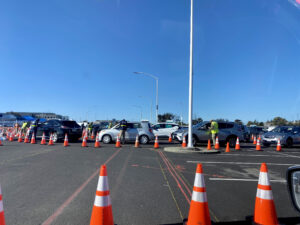On Sept. 21, 2020, Vice President of Strategic Affairs Renee Jadushlever sent an email to students regarding protocols for accessing the campus and COVID-related policies during the pandemic. Classes have gone completely virtual, but housing remains open for students and faculty. At the end of the email, students were notified that there had been three positive cases of COVID-19 on-campus.
“We have had three positive cases of COVID-19 on campus. When a positive case is reported to Benefits (benefits@mills.edu) for staff/faculty or to Student Support (support@mills.edu) for students, the contact tracing process begins,” the email read. “It is imperative that we have updated cell phone numbers for everyone on campus to enable the College to effectively contact people as quickly as possible. The easiest way to do that is through RAVE, Mills’ Emergency Alert System. We appreciate everyone doing this right away, if you have not recently updated your cell number, so our information is updated and accurate.”
When reading this information, students’ concerns increased about the confirmation dates of COVID-19 on-campus and unknowingly being exposed to the virus while living in residential halls. Students would have hoped for a sooner notice of the confirmations and during a time of uncertainty, they feel transparency is important.
“It’s not at all relieving to hear that the vaguely announced positive COVID cases were in fact from several weeks ago. It makes me concerned that there are currently active cases that we don’t know about and that [students] will only learn about in another several weeks. We as students have the right to know information that could impact our health and well-being as soon as the college learns of the information,” Riley Hartmann, a first-year at Mills, said. “Learning that the cases were from several weeks ago makes me more panicked than when I thought they were recent/active, because now instead of assuming that there are no positive cases on campus, my thought is that when there actually are positive cases on campus, we won’t be informed until weeks later.”
The day following VP Jadushlever’s email, The Director of Residential Life & Community Standards Dr. Maria-Anderson Long contacted students to provide additional information. She confirmed that the three positive cases mentioned in Vice President Jadushlever’s email were from several weeks ago and that currently, Mills is not aware of any additional positive cases on-campus.
Even with the clarification, students prefer to be notified of positive COVID-19 cases on-campus as soon as possible in order to protect themselves. They would also like to be informed of what happens to a student who has to quarantine/isolate so students will feel more comfortable reporting their symptoms.
The Graduate Employee’s Organization (GEO) at the University of Michigan, a labor union that represents graduate student instructors and graduate student staff assistants, were on a labor strike from Sept. 8-16, 2020; its purpose to protest the university’s plans to reopen this semester.
Students who lived on-campus reported a lack of others wearing masks, social distancing, testing and poor treatment of students who were isolated due to a positive test result.
A protocol for COVID-19 related policies was established at Mills starting last March when Alameda County was put under shelter-in-place orders. Even with these policies in place, some students do not feel entirely safe due to a lack of enforcement of social distancing guidelines in residential halls.
Hartmann feels that Mills should be more transparent about positive COVID-19 cases on-campus and offer more resources for testing. They are currently a remote student but feel that the current protocols would prevent them from feeling comfortable returning to campus in the spring.
“For starters, be transparent and give clear and direct guidelines of what will happen if students test positive and what would happen if they report symptoms so that we can ensure more accurate information. Also, Mills very much needs to just have regular testing be a standard part of the protocol of living on campus. If California doesn’t have enough tests for that, then Mills should not allow so many students back on campus.
At [a] minimum, students should be tested and required to quarantine for two weeks after moving into campus. Ideally, every student should be tested every two weeks as an ongoing process throughout the semester. If not that, then have tests for students who choose to go off-campus, especially those who go out of state or drive further than a grocery store trip. The lack of testing is honestly what’s the most concerning to me, because right now Mills is relying entirely on students self-reporting symptoms and taking the initiative to get their own tests which, to be frank, just won’t happen. Mills needs to be testing all students regularly and can’t rely on self-reported symptoms to choose who to test,” Hartmann said.
At Mills, there is a contact tracing protocol established for students, faculty and staff so in the event of a positive case on-campus, everyone who was in contact with that individual can be notified.
“All staff who report a positive test must go through our contract tracing process. Several Mills staff have been trained to do contract tracing for COVID-19. Anyone who has contact with an individual who tests positive or is awaiting test results is contacted directly and immediately. In the most recent cases, which were several weeks ago, the staff who reported had very little and limited contact with individuals on campus and everyone they came in contact with was informed and direct to test and/or quarantine,” Dean of Students Dr. Chicora Martin said. “We are in the process of creating a dashboard of testing outcomes which will be available on the Mills website soon so folks can see any reports.”
Before this semester began, students were informed that accurately reporting their symptoms was apart of their agreement when returning to campus.
“We hope that our students report accurate information as part of their care for each other however if we find that a student is not following any of the COVID-related requirements, those items are now in the Student Code of Conduct and could result in conduct charges, ” Dr. Martin said. “RAs and Area Coordinators discussed these requirements with all residents at the beginning of the year. Just like other policies in the halls, these requirements will be enforced via our process of education and documentation when required.”
Students who are asymptomatic, not showing any symptoms of COVID-19, can get tested at the Vera Health Center on-campus or contact them for testing options if they have been exposed. There is a strong isolation protocol for students in an occupied residential building. According to Dr. Martin, students that are in insolation, are provided with meal delivery, daily check-ins and other forms of support.
According to an email from VP Jadushlever, all parties including staff, faculty, students, guests and vendors are required to complete a daily symptom check when entering the campus and show the Department of Public Safety officers its’ completion at the security gate.
For example, if a driver is accessing the campus to drop off a student or employee who is staying on-campus, the student must show their MillsGo app authorization to the DPS officer through their window. The driver should not exit the vehicle or enter any campus building and should remain on-campus for only 15 minutes.
If a resident on-campus is receiving a delivery, they must meet the driver outside of their residence. After dropping off the delivery, the driver should leave the campus immediately. In this case, the driver is not required to complete the daily symptom check.
On Sept. 22, 2020, the California Secretary of Health and Human Services Dr. Mark Ghaly announced that five counties, including Alameda County, would move from the purple tier to the red tier, and are authorized to allow more businesses and schools to reopen in the state’s new reopening structure.
At the time of VP Jadushlever’s email, the Alameda County Public Health Department had classified Alameda County a purple tier county, meaning this area has the highest risk of COVID-19 transmission. Now classified as a red tier county, Alameda County faces lesser restrictions. With this change, students may expect a review of the current access to campus.
“We continue to actively monitor State and Alameda County Public Health Department mandates and look forward to the county being able to move into a less restrictive stance,” the email read. “As things begin to improve, countywide, and our tier moves to red, we will review the campus situation and try to provide broader access.”
During the recent Associated Students of Mills College (ASMC) student body elections, Hartmann has been elected the Student Support and Services (SASS) senator. With their position, they aim to improve communication between the SASS department and Mills’ students. A large part of their campaign included discussing the issues of getting in contact with a representative. The low staff rate of the department concerns Hartmann in its’ status of being in charge of contact and tracing of COVID-19 on-campus.
“I want to implement methods to allow the SASS student assistants to take on some of the caseload without violating confidentiality, such as alterations to the application process. I also will hold regular office hours in addition to by appointment so that students can come to me if they’re struggling to get in touch, and I can then act as a bridge for communication between students and SASS by advocating on their behalf,” Hartmann said. “My disability doesn’t affect communication, so I really want to utilize that to help advocate for those whose disability does affect their communication. I am able to get in touch with SASS because I am comfortable repeatedly following up and having other departments contact them on my behalf, but many students aren’t. In addition to this, I want to become a point of reference for all things accessibility, so that questions that don’t absolutely have to be answered by SASS can be directed towards me instead.”





